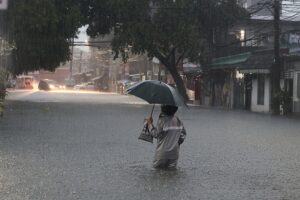
La Niña chances at 66% between September and November
La Niña has a 66% chance of occurring between September and November, with recent inclement weather serving as early warning signs, according to the Philippine Atmospheric, Geophysical and Astronomical Services Administration (PAGASA).
The recent heavy rains were caused by the enhanced Southwest Monsoon and severe tropical storm Enteng, which has now been downgraded to a tropical depression after battering China.
Also, two low-pressure areas (LPAs) are being monitored outside the Philippine Area of Responsibility (PAR) as they might develop into tropical cyclones.
“These are the precursory signs of developing into La Niña. Our warm waters near our Philippine Sea or the sea surface temperature is becoming more favorable for rain-bearing weather systems,” Ana Liza Solis, chief of the climate monitoring and prediction section of PAGASA said in an interview.
La Niña phenomenon heightens the likelihood of several weather disturbances, including Tropical Cyclones, LPAs, and the Intertropical Convergence Zone (ITCZ), and intensifies the ongoing Southwest Monsoon, Ms. Solis said.
Once declared, La Niña is expected to last until the first quarter of 2025 (January to March) and could trigger an additional six to ten tropical cyclones by the end of the year, which is still below average.
“In general, makikita natin, this is below average from the twenty tropical cyclones that we could receive in a year,” Ms. Solis said.
Areas in the eastern section of the country, including the Bicol region, Eastern Visayas, and Eastern Mindanao, are the most vulnerable to the potential threat of La Niña.
“This La Niña may bring heavy rainfall events which may result in flooding and then induced landslides, lalong-lalo na doon sa mga highly vulnerable areas natin (especially on our highly vulnerable areas), therefore mas high ang risk (therefore the risk is higher) and floodings may become frequent,” she said.
PAGASA is bolstering its La Niña awareness efforts, particularly in highly vulnerable areas, by conducting commissioned forums.
Mrs. Solis highlighted the importance of the community’s coordination with local Disaster Risk Reduction and Management Offices (DRRMO) in preparation for La Niña.
For public, “always have your disaster emergency kit ready,” and to regularly check flood warnings and advisories from PAGASA, Ms. Solid said. – Edg Adrian A. Eva



